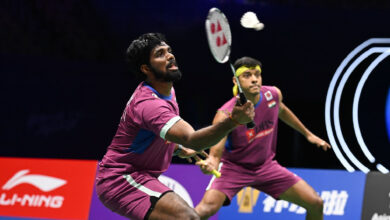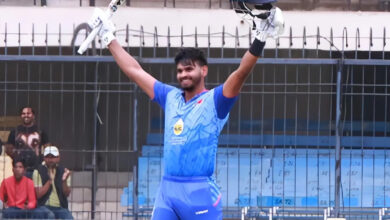T20 World Cup: How Kane Williamson produced a strike rate of 174.28- 61 off 35 balls- despite not being at his best vs Ireland

Kneeling on one knee, every strand of muscle on his forearm flexed, Kane Williamson, slog-swept the 32nd ball he faced in the innings over cow cordon. As the ball sailed into the stands, his partner Daryll Mitchell rushed in and embraced his captain. Williamson broke into a shy smile, before he unwrapped the helmet and waved his bat, reluctantly rather than wildly at the dressing room and the scattered crowd at the Adelaide Oval.
There was so much noise around Williamson. That he is not scoring runs; that he is scoring runs slowly; that the elbow was still hurting; and most shockingly, that he has been a burden for his team this tournament.
All of this chatter has, of course, come from outside the dressing room. His teammates and support staff had done their bit to assert the importance of being Kane Williamson. Glenn Mitchell called him “pure gold at No.3”; Mitchell Santner called for patience and reminded the reporter to not forget the past. There is genuine goodwill and love for Williamson.
Then, as often as he does, Williamson shut out the noise himself without making any noise himself. The celebrations were mild, to put it mildly. There were no finger-wags, or air-swipes, or even a routine skyward gaze. He had no statement to make; no point to prove, no burning hubris. He bats like silk, but he is made of granite.
New Zealand’s Kane Williamson bats during the T20 World Cup cricket match between New Zealand and Ireland in Adelaide, Australia, Friday, Nov. 4, 2022. (AP Photo/James Els)
He just wanted to score the runs that would make the difference for his side, and his 61 off 35 balls (strike rate of 174.28) was the difference between the two sides in the end. His knock corner-stoned New Zealand’s 185, which the Irish fell short 35 runs. Though they threatened to script another upset with an opening partnership of 68 in eight overs and inject further intrigue into the semifinal equation, Williamson’s men, like their captain, kept cool and snuffed Ireland’s hopes with timely wickets. The margin of victory ensured that their net run-rate hit 2.113, and although they are not mathematically assured of a semifinal spot yet, they are the outright favourites to reach the last four from their group.
The knock stood out not so much for the quality of his stroke-play as for the resolve he exuded. Williamson was a few miles behind his best. He struggled for timing, he was uncharacterically hitting the ball too hard. He sweated for placement, often the fielders needn’t have to move a metre from the stations. He scratched and scraped — it was not a Test innings where he could block his way back to form. His team needed him to rediscover his form; they also needed quick runs on a surface, although devoid of lateral movement and disconcerting bounce, was on the sluggish side.
But Williamson was determined, willed to embrace whatever it takes to kill both birds in one stone. The staple, high-percentage strokes, the cuts, drives and pulls, were not coming off. So he sought riskier alternatives, more shots through the air, more swipes across the lines, more slogs and swipes, more calculated aggression than seamless stroke-making. Many a time, to both seamers and spinners, he would sashay down the surface. Four of his five fours were hit in the air, to go with three sixes (a pull, slog and slog-sweep apiece). There was little desperation in his body language, but rather an eagerness to be back amongst the runs, to be back influencing games for his country. Lest you forget, this was a match New Zealand required to win to keep their semifinal hopes flickering.
New Zealand captain Kane Williamson, left, talks to bowler Tim Southee during the T20 World Cup cricket match between New Zealand and Ireland in Adelaide, Australia, Friday, Nov. 4, 2022. (AP Photo/James Els)
The slog sweep that brought his half-century captured the essence of his innings. It’s a stroke that he usually preserves for this format, and as a last-gasp option. He premeditated the shot, crouched low as the bowler was about to release the ball and then bend his knees. Barry McCarthy slowed the ball a little and shortened the length, but Williamson made the required adjustments. He delayed his shot and hit the ball squarer, though there was a fielder prowling the boundary. He knew his power would beat the fielder.
this time, he was hitting at a strike rate of nearly 150. Just moments ago, he was barely scoring at a-run-a-ball. Then, there are few cricketers around, apart from Virat Kohli, who could switch from an anchor to aggressor as smoothly as Williamson could. At one stage, he was 15 off 15 balls. Then in the wink of an eye, he was 42 off 29. His Sunrisers Hyderabad coach Tom Moody has once spoken glowingly about this gift. “He can accelerate without you even noticing him. He will be at run-a-ball, then all of a sudden hitting at 150,” he had said.
He also lets the stroke-makers blossom around him. “With his experience, the ability to take a game deep and command the middle overs is crucial. To be able to have myself, [James] Neesham, Daryl [Mitchell], as well as [Mitchell] Santner doing our role at the end, having Kane doing what he’s doing at the moment is crucial for us,” Phillips had said.
His presence gave Phillips the licence to attack from the first ball. He pummelled a nine-ball 17 to pump in the impetus after Devon Conway’s laborious 28 off 33. Earlier, Finn Allen had compensated for Conway’s crawl with 32 off 18 balls. And when Mitchell walked in, Williamson assumed the aggressor’s role, giving him adequate time to settle down before teeing off to 31 not out off 21 balls, despite a hat-trick from Josh Delaney, that could in the end just prevent New Zealand from crossing 200.
It was not perhaps Williamson’s most bewitching knock, but as always, it was of high value for himself as well as his team. But typically, he deflected his glory to his teammates. “The guys were brilliant in negating the new ball and give us a good start. It was a very competitive total. The guys with the ball adjusted nicely, the spinners came in, and they did their job,” he would say at the presentation.
As for his knock, he gave just a one-liner: “Nice to get some momentum.” The team, that would matter more to Williamson than personal fortunes.
What’s the semifinal scenario?
New Zealand have seven points from five games, with a run rate of 2.113, the best in the group. Both England and Australia could reach seven points, should they win their last game, against Sri Lanka and Afghanan respectively. Both, though, would require to win the game handsome margins, more so Australia, whose net run rate is -0.304. England’s is a rosier +0.547. However, if Sri Lanka do manage to beat England, and Afghanan upset Australia, Sri Lanka could progress. In case, the Afghanan-Australia game is washed out, and both split a point, Sri Lanka would have to beat England convincingly, as they have an inferior run-rate (-0.457) to Australia’s.







